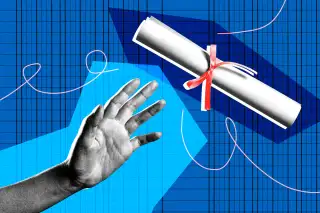Is Your Graduate Degree 'Professional'? The Answer Will Determine How Much You Can Borrow

The Education Department is nearly finished classifying graduate degrees in a new set of rules that will determine how much students can borrow from the federal government.
At the heart of the issue is officially codifying the term "professional degree," which in the past was used generally to refer to programs tied to a specific career, like law school or medical school. While not finalized yet, the department has opted for a narrow definition of the term following rounds of negotiated rulemaking that ended this month. The decision effectively cuts federal funding opportunities in half for students who fall outside of the new definition.
The reclassification is part of a broader effort by the Education Department to implement key provisions from President Donald Trump’s “big, beautiful bill” legislation enacted this summer.
Among several changes to federal student lending, the law sets new lending limits for advanced college degrees. For graduate students, the limit is $20,500 per year ($100,000 total), while "professional" students get a $50,000 annual limit ($200,000 total). The lending limits go into effect July 1, 2026. Both new limits represent much tighter lending caps compared with current rules that allowed for students to essentially borrow any amount — up to the cost of attendance.
New ‘professional degree’ definition
Under the new proposal, a “professional degree program” must meet three main criteria.
It must educate students for a profession that requires skills beyond a bachelor’s degree. The education should be generally at the doctoral level and requires at least six academic years of college education for completion, including two years above bachelor’s level. And the profession itself must generally require a license to start practicing. (The definition is not a reflection of professionalism, as in the quality or validity of the field of study.)
Examples of programs that meet this definition include doctoral programs in law, pharmacy, dentistry, veterinary medicine, medicine, osteopathic medicine, podiatry, optometry, clinical psychology, theology and related fields.
Notably, the definition does not include degrees in advanced nursing, physical therapy or engineering, which are often colloquially considered to be specialized, "professional" fields.
Students in programs that don't meet this new definition would be limited to $100,000 of federal student loans. The Education Department says the new loan limits are necessary because the previous rules incentivized colleges to offer costly degree programs and made it easy for students to overborrow.
“This will benefit borrowers who will no longer be pushed into insurmountable debt to finance degrees that do not pay off,” Under Secretary of Education Nicholas Kent said in an announcement earlier this month.
The proposal faces push back
Several education advocacy groups have expressed concerns that the new definition could make things worse by pushing graduate students into private student debt after they’ve reached their federal loan maximum.
According to the National Association of Independent Colleges and Universities, the new interpretation of professional degrees excludes about 90% of all grad programs and prevents the lending cap “from adapting to new and emerging professions.”
Jennifer Mensik Kennedy, president of the American Nurses Association, says the $100,000 lending limit for grad students especially impacts nurses.
“I completed all my education over 20 years ago, and I paid $100,000,” Kennedy said in a CNN interview. “This education is much more expensive today.”
Likewise, Lancette VanGuilder, president of the American Dental Hygienist Association, critiqued the new classifications Friday. Dentists meet the professional student definition, while dental hygienists do not.
“Limiting access to federal student loans will force students to seek private loans with higher interest rates,” VanGuilder said, “making advanced education less accessible when we need it most.”
Meanwhile on social media, borrowers are railing against the changes.
“If the Department of Education doesn't recognize our degrees, we won't acknowledge our student loans,” Ariana Jasmine says in an X post. “It’s literally that simple.”
On Reddit, some users note that even for the degrees that do qualify as “professional,” the lending limit is too low.
“This feels like an overcorrection,” one user wrote, noting that medical doctors often pay much more than the $200,000 federal loan limit.
The Education Department did not respond to Money's request for comment.
“This is devastating,” Kennedy with the nurses association said. “We're hoping they change this proposal."
More from Money:
College Costs Were Flat for Many Years. Now They're Back on the Rise
What Happens to Student Loans if Trump Shuts Down the Education Department?